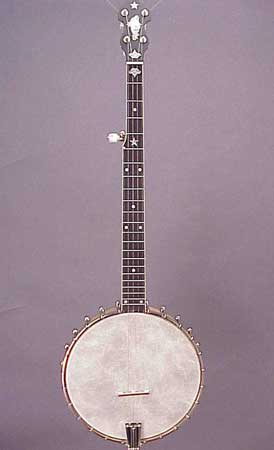A Bouquet of the more common
Banjo Types
© Frank Ford, 7/11/00; Photos by FF
Rather than try to make this a discussion of the historical evolution of the banjo,
I'll just present a few of the most common types of banjo you're likely to run across.
In order to give you a sense of scale (pun intended) I'll mention the vibrating string
length, measured from nut to bridge, which is the usual method of describing
instrument sizes.
Please click on any of the photographs to zip over to the full Museum or New Instrument
Gallery article which includes a full series of photographs of that particular instrument.
Here's today's most popular style, the resonator 5-string:

It is the only style banjo used in bluegrass music, and it is played in a syncopated
picking style, using fingerpicks. Bluegrass banjo players usually use
G-tuning for most regular playing (G,D,G,B,D, starting with the fifth string) or
D-tuning (A,D,F#,A,D). C-tuning (G,C,G,B,D) is a common folk tuning sometimes used
in bluegrass.
This earlier style 5-string banjo is an open back banjo, or non-resonator banjo:

The open back banjo is often called a "frailing banjo," "old time
banjo" or "clawhammer banjo," after the playing styles, which generally
involve a rhythmic right hand technique, using no picks. In playing old time music,
there are lots of major, minor and modal tunings, many of which are unique to certain
melodies.
Both styles of five string banjo have scale lengths ranging from 26 to 27 inches,
and 22 frets.
Illogical as it may seem, the five string banjo is the first banjo style which
developed as the banjo came of age in the 19th century. For that reason, most banjo
factories called them "regular banjos" to distinguish them from some of
the newer types. Even today, the suffix "RB" is attached to the model designation
of all Gibson five string banjos.
In the late 1950s, Pete Seeger figured he could use a lower tuning
to accommodate his singing voice. So, he had a special banjo constructed, with the
neck extended an extra three frets at the low end:

This is one long banjo! Its scale is a hefty 32 inches, and it has 25 frets. Pete
Seeger, and later the Kingston Trio, became so popular that thousands of long neck
banjos were built and sold to eager folk musicians, many of whom bought the long
neck because of the "look."
Take the fifth string off a regular five string banjo, and you have a plectrum banjo:

In fact, that's just how this instrument developed. Players, wanting to be heard
in the new jazz bands, simply discarded the fifth string and strummed the banjo,
chording it with a pick, or "plectrum." Plectrum banjos have the same scale
length (26-27") and number of frets (22) as regular five string banjos. Tuning
is either the same as C-tuning on five string (C,G,B,D, low to high) or the same
as the first four strings of a guitar (D,G,B,E).
Shorten the neck to 19 frets (or 17 on some earlier styles) tune it like a mandola
or viola in fifths (C,G,D,A) and that's a tenor banjo:

The tenor banjo was the single string melody king of the jazz age, and professional
models were often elaborate and gaudy, like this one. It was played exclusively with
a flat
pick, just as the plectrum plectrum banjo. Today, lots
of tenor banjos are finding their way into traditional Celtic string bands. Tenor
banjos have scale lengths from 21 to 23 inches.
If you had been a mandolin player and wanted to join the fun of the new jazz music,
you might turn to a mandolin banjo:

Like all the hybrid banjo family, it takes its name, tuning, and playing style
from its neck. Tuned in fifths just like a mandolin (G,D,A,E, from low to hihg)
and a scale length from 13 to 14 inches, the mandolin banjo was popular during
the 1920s. Mandolin banjos were and are always played with a flat pick.
Even more popular at that time, the ukulele banjo was the collegiate favorite:

Tuned like a ukulele, and strung with the same gut strings (nowadays, nylon) as a
ukulele, the ukulele banjo is a perfect instrument for the kids in the family whom
Dad would like to keep off his bluegrass machine. The scale length is 13 to 14 inches,
the same as a standard soprano ukulele.
Traditionally the banjo varieties take the first part of their names from the
style of the neck and the way in which they are tuned and played. The ukulele banjo
is the only one with an assortment of nicknames, including "banjo uke"
and "banjolele." In fact, it's most commonly called "banjo uke."
Suppose you played guitar, and wanted to get in on the banjo fun?
Not to worry, there's the guitar banjo:

In fact, this is a new guitar banjo, made by Deering. Tuned like a guitar (E,A,D,G,B,D)
the guitar banjo has a scale length in the 26 inch range, just a bit longer than
the usual guitar scale. Every time I see one of these critters, I think of the Sam
& Kirk McGee, stars of the Grand Ole Opry. If you haven't heard their raggy country
blues, you've really missed something!
These are the seven most likely kinds of banjos you'll encounter in this country.
Suffice it to say that there are myriad others, mostly of historical interest. So,
you may hear about the banjeaurine, piccolo banjo, cello banjo, tango banjo, zither
banjo, and others. I'll save such instruments for a discussion (maybe later) on banjo
evolution.
Back to Index Page







